“The principles were really good” – Former Cadre Testifies
Today, anonymous witness 2-TCW-1005 continued his testimony. Former messenger and Division 117 Deputy Chief told the Court about arrests and replacements of senior cadres in his region as well as communication between different offices. He defended the moral principles that they were taught, but qualified it by saying that it depended on individual implementation. Moreover, the witness gave an account of forced marriages during the Democratic Kampuchea regime.
Arrest of Senior Cadres
The International Lead-Co Lawyer for Civil Parties Marie Guiraud was absent due to personal reasons. All other parties were present.
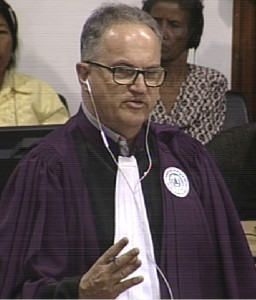
International Deputy Co-Prosecutor William Smith
International Deputy Co-Prosecutor William Smith started his questioning of the day by summarizing the last part of the witness’s testimony yesterday: eleven people from Sector 505 Sector 505 in Kratie had been sent to Phnom Penh by Office 870 when working at Division 117. Mr. Smith asked whether he had heard of these people being alive after they had been sent to Phnom Penh. The witness answered that they never returned and were replaced by other cadres.
For example, Phon, alias Thy, the deputy chief of Sector 505, disappeared. “They were no longer alive.” The people who arrived after the witness’s superiors had gone to Phnom Penh told him and others that their superiors were considered traitors. He knew that Nheang passed away, but did not know about the fate of Phon.
Mr. Smith moved to the S-21 list compiled by the Office of the Co-Investigating Judges and pointed to six individuals, who had been arrested and sent to S-21.
First, Leang (number 7862), was arrested from Division 117 and entered S-12 on December 1 1978.[1] The witness confirmed that he knew that person. He was also on the plane from Kratie to Phnom Penh. Second, the next person was Deputy Secretary of Sector 505 Chhim Khon. He entered S-21 on December 2, 1978. The witness also confirmed knowing this person and said that his wife was called Ra.
Third, Mr. Smith pointed to Meas Moeung (number 13396), which was also confirmed by the witness. The witness could not recall the specific date of entry, but knew the number of people who were sent there. He did not work far away from the witness. He was the regimental commander at Angkor Borey and was related to the witness’s uncle. Thus, they had some contact, but not much that was work related. He also saw that name on the list.
Rom, Yeang and Phon were on the same plane. However, the witness did not enter the airfield. “At that time, I was rather happy that my superiors had to go away so that I would have some free time”. Later, he was surprised that they were replaced.
Fourth, Khun Rom (entry 4032), was Division Secretary of Division 117. The witness took him to the plane on that day. He confirmed that this was his uncle.
Fifth, Mr. Smith asked about Huon Yeang (entry number 1290). The witness confirmed that he had taken him to the airport. Some people were sent to S-21 and others to Kampong Chhnang. Not all of the eleven people were taken to S-21. “From what I understand, the situation was intensified on the first of December 1978. There were two groups of people who were sent. […] At the time, the attack was intensified.” He said that the Vietnamese were attacking and that they had to fight back.
Sixth, he said that Chhum Chang (12,904) was his uncle and also taken to Phnom Penh. He was the youngest brother of his father and a friend of Khun Rom.
Mr. Smith asked whether it was possible that the leaders left for Phnom Penh on different dates, since their entry date varied between December 1 and December 12. To the witness’s knowledge, Chhin and Rom came together.
Mr. Smith referred to another witness’s testimony.[2] This person was called Dol, and had said that Meng and Rom left on a different plane a few days apart. The witness replied that Dol was the chief of the sector office, and that if he said so, this must be a more accurate account. The witness was in charge of telegrams and messages and to drive people around, while Dol might have had more knowledge. Rom, Phon and Chhin were “in the same journey”, he said.
They held a meeting amongst all 70 people in the office and they were told that their leaders had ben traitors. During this meeting, Meas Muth spoke, but was there for not more than one hour. Meas Muth mentioned that his group had not fought hard enough against the Vietnamese and that Snuol District had been captured. “After hearing this message, we felt hatred in our heart and fought harder”. They were told to be absolute and they “heard that the yuon were annexationists.” He elaborated on how they had tried their best to fight back the Vietnamese.
“Frankly speaking, in terms of our sentiments toward our leaders and in terms of our struggle […] 800 soldiers lost their lives in a period of seven or eight months. We were disappointed that our leaders were traitors […] So what could we do? In order to be absolute, in order to defeat the other, we had to do our outmost.”
The witness said he left the forces in 1998. He remained with them after the fall of the regime.
Forced Marriage
Mr. Smith gave the floor to his national colleague Song Chorvoin, who inquired about his personal background.
He married Prak Yut in 1982: “It was not out of love”. After his mother passed away, he married and they had one child together. He remarried in 1997. In Kratie, they did not have the traditional wedding ceremonies. He recounted that a medic loved a patient once and could request to get married. This was not forced marriage. There were marriage ceremonies held. Sometimes, spouses were already selected for those who were to get married. Usually the requests were made by men.
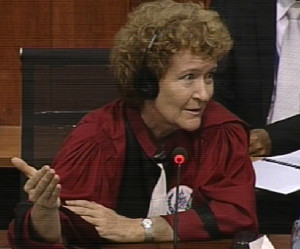
Judge Claudia Fenz
When Ms. Chorvoin asked another question, Nuon Chea Defense Counsel Victor Koppe objected and said that this lead to speculation. Judge Claudia Fenz reminded him that they had already informed the witness yesterday to only answer questions without speculating. Khieu Samphan Defense Counsel Anta Guissé argued that procedurally the defense teams could only object to specific questions and therefore had to object now. Judge Fenz replied that the objection that the answer of the witness would be speculation was itself speculation, since they had not heard the witness’s answer yet and she had instructed the witness already not to speculate.
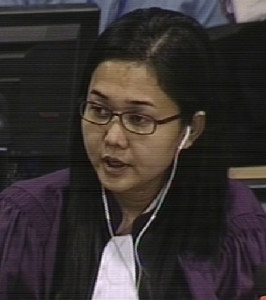
National Deputy Co-Prosecutor Song Chorvoin
To overcome this issue, Ms. Chorvoin referred to his statement, in which he had referred to forced marriage.[3] The witness confirmed this. “When I moved around to different units, I saw the marriage regulations. Whether or not they loved each other [they would get married]”. The marriage ceremony would be held for five to eight couples. Also in Takeo men would usually propose to men. They were told that base people could only marry base people, since New People had different backgrounds.[4] There would be a risk to be accused of being affiliated with the KTB, for example. Thus, “Progressive people should only propose to their own peers”. He gave the example that he would not be able to love a 17 April Person. Ms. Chorvoin inquired why women were not allowed to refuse marriage when they were proposed to.[5] The witness answered that people were matched with their respective units. “If they were to refuse, they might be removed to work in a cooperative or a mobile unit.” According to the Party’s policy, if someone opposed the guidelines, this person would be seen as opposing the party. For example, if he had refused to get married, “I would be considered to oppose the party”. People were afraid of this. “During the time, we did not have any right to refuse or protest, as we do it now”. They were allowed to stay together to consummate their marriage for three days, after which the husband would be sent away. After around ten days, the husband could request to visit his wife. They were not allowed to live together.
There was a meeting, during which marriage regulations were raised. The guidelines were given to them by their supervisors in meetings, but not in writing. When he was in Takeo, Phon would chair the meetings prior to 1975. When he was with Khun Rom later, he spoke about these guidelines. If someone wanted to propose to someone else at the commune, the marriage would be organized at the military unit.
At this point, the President adjourned the hearing for a break.
Twelve Moral Principles
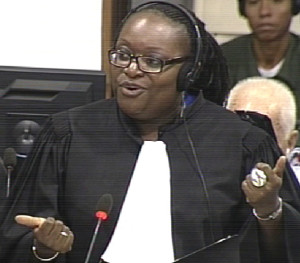
Khieu Samphan Defense Counsel Anta Guissé
After the first break, the floor was granted to the Khieu Samphan Defense Counsel Anta Guissé. She remarked that documents that had been requested by the Co-Prosecution, should be made available by the Chamber, since the expert would be heard earlier than expected. Moreover, the Co-Prosecution had requested another number of documents that needed to be made available to the defense.[6] There was a brief discussion between the bench, the Co-Prosecution and the defense team about this disclosure.
Nuon Chea Defense Counsel then started his questioning. Mr. Koppe asked whether he was aware of the so-called 12 Revolutionary Principles. The witness answered that there were documents relating to ethics. “The principles were really good in their terms […] The messages in those principles were so good!” He stressed this several times and said that the principles were “so amazingly good”. Later, they did not trust each other anymore. After becoming a member of the Party, they were afraid of each other and did not trust one another. People were accused of mistakes. In June, the Vietnamese were advancing into the country, and the high-level cadres did not trust each other either.
Mr. Koppe wanted to know whether one of the principles related to marriage or the founding of a family. He was uncertain: “The principles were so amazingly good, but it depended on one particular individual”. “Everyone wanted good lives, and the leadership wanted the same”. The principles were applied differently in different locations.
Pressing on the issue of forced marriage and family relations, Mr. Koppe asked whether he remembered that there was a principle that instructed them “to not behave in any way that would violate women”. The witness could not recall the exact principles. “We were required to act good to our unit and our people”. Elaborating further, he said that they hat to “respect one another”. Mr. Koppe then asked whether one of the principles said that the marriage had to be agreed upon by three parties:
- that both parties – men and women – agree
- the collective agrees
The witness said that he could not recall the principles. Moreover, the implementation of the principles depended on individuals. Mr. Koppe read out the principle.[7] The witness reiterated that the implementation were based on “individual understandings”, even if they attended the same meetings.
Vietnam as Aggressor
The Division 707 troop was sent to Kratie to counter the invasion by the Vietnamese. Snuol was captured by the Vietnamese, so they tried to re-capture it along National Road 7.
He could not recall whether the Vietnamese arrived in 1977 as stated in the statement.[8] However, the rubber plantation at Snuol was captured by the Vietnamese in March 1977 and their fighting lasted until 1978, when the Vietnamese invaded the whole country. They had occupied the rubber plantation already when he arrived.
Mr. Koppe asked whether he knew why Vietnamese forces invaded the rubber plantation in Snuol.
Mr. Koppe inquired what he meant when he said in his interview that the Vietnamese “struck hard”.[9] He replied that Division 703 from Kratie was sent to the border. In the Northeast Zone, there were only Division 801 and Division 920. In Kratie, there were no zone armies – only the sector army 707 existed.
Someone had asked him over the phone whether he knew Leang, which he had confirmed, and subsequently Leang was arrested. He learned later that his voice was recorded. He received a telegram that “the yuon” were attacking. “We were defeated in a number of locations, because we did not trust one another”.
Mr. Koppe then wanted to know whether the Vietnamese had started the conflict in March 1977, which the witness confirmed.[10] The fighting intensified after he had left Kirivong.
At this point, Mr. Smith interjected and said that the time period the witness was referring to in the extract Mr. Koppe had read was referring to late 1978.
The witness elaborated on the fighting by saying that the Vietnamese attacked first. “We did not start the fight first.”
Questions by the Bench
Under the questioning of the Trial Chamber President Nil Nonn, the witness said that he had two office: one in Snuol and one in Kratie. This belonged to Sector 505. In Kratie, the sector was autonomous and not under the Northeast Zone. Since it was under the direction of the Center, he would collect supplies and letters in Phnom Penh.
He received the letter when “the yuon were advancing deeply into the country”. Telegrams had to be encoded and decoded.
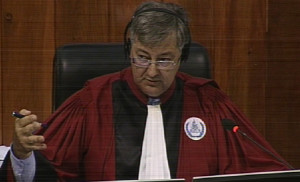
Judge Jean-Marc Lavergne
The president then wanted to know why the orders were not issued to Special Sector 505, him being the Deputy Chief of Division 117. Thy was the one who encoded the letter. After delivering the letter, Thy drove the vehicle north, and the witness was asked to read the letter. With this, the president handed the word to Judge Lavergne, who wanted to know whether reports were also sent to M-870. He replied that the sector was assisting in copying the letter. As for letters and telegrams, the witness explained that letters in hard copies were not sent to him directly but were rather communicated with him through telegrams. He saw an annotation on one occasion that belonged “to an uncle” and related “to the advancement of the yuon”. The orders would come to M-870 first before reaching the general staff. His division had to report to their immediate supervisors, before their messages would be forwarded. “We never went beyond our responsibility”.
The infantry and naval commanders would communicate with one another. The witness was in Division 117, while Meas Muth was at the general staff level. The commander in chief was Son Sen. Sous Met was “another individual” that the witness remembered. “I could send messages or reports to Son Sen, Meas Muth or Sous Met […] asking for ammunition”. Before the arrest of the 11 individuals, “the uncle went there in late November”. After the arrest of that person, the other 11 individuals were also arrested. Vorn Vet was the former minister of commerce and examined the situation at Kratie for three days in November or December.
He did not know whether Nuon Chea or Khieu Samphan visited Sector 505 while the witness was stationed there.
Preparation for Expert Testimony
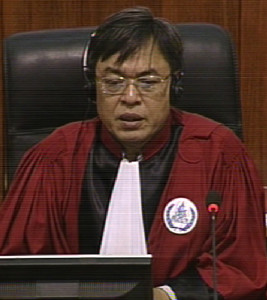
Trial Chamber President Nil Nonn
Before giving the floor back to the defense teams, the president invited observations to an e-mail by the Nuon Chea Defense Team to question Henri Locard next week Monday. For the Co-Prosecution, Mr. Smith argued that the new edition of the book was recently placed on the case file and that they would have no objection for the defense to start questioning the expert on Monday. He requested to start questioning the expert not tomorrow after the conclusion of this witness’s testimony. The Civil Party Lead Co-Lawyers had no objection to postponing the defense team’s questioning. The Khieu Samphan Defense Team had no objection either and welcomed the proposal, pointing to the number of pages that had to be read through before the questioning.
There was a discussion about the identification of specific passages in the book by Locard that the Prosecution intended to use, at the end of which the Trial Chamber decided that the Chamber would continue questioning tomorrow morning. It instructed the Prosecution to identify the specific passages they would use by the end of the day.
Conflict with Vietnam
Mr. Koppe then took up his questioning of the witness again and asked what he meant that “the Vietnamese colluded with those forces”. He explained that the “Vietnamese forces would attack through those gaps” that existed in their defense, since the Democratic Kampuchea army had less soldiers. “And in fact, by 1978, we did not trust one another, because some sections of the border defeated the Vietnamese side, but others were defeated”. Mr. Koppe summarized that members of Democratic Kampuchea forces leaked intelligence on locations of Democratic Kampuchea troops to Vietnamese forces and asked whether this was a correct summary. The witness asked whether it was the counsel’s own proposal. Mr. Smith objected: “This is not what the witness said at all”. He requested sources for this. “This is certainly not what the witness said’. Mr. Koppe rephrased his question and asked whether DK forces leaked intelligence to Vietnamese forces. He replied that he could only speak about the location where he was stationed. Two hundred or three hundred soldiers died in that year at that location and someone told them that Vietnamese troops were advancing. “And then the suspicion rose and that led to mistrust”. Those who betrayed fled to the Vietnamese side, “and only the soldiers died”. He did not know which soldiers fled to Vietnam.
They were “under heavy attack” by the Vietnamese side. Bombs hit the Chnuol office and the warehouse. He could not give more information on soldiers fleeing to Vietnam, even when Mr. Koppe referred to the defection of Hun Sen.
“The fightings were in all directions” in 1977, the witness said. He told counsel that repeating his questions did not lead to new answers. He received this information through telegrams. “There were no more than 100,000 soldiers in the DK army, frankly speaking”. He insisted that the questions were repetitive for him.
Moving on, Mr. Koppe wanted to know whether the witness knew the commander of 805, which the witness confirmed: it was Brother Roeun, who was also known as Brother 05. They communicated sometimes through telegrams in relation to logistics. “However, I did not have any close relation with him”.
Rom was not Brother 05 and was first stationed at Koh Kong and later promoted elsewhere. At this point the President interrupted the questioning and adjourned the hearing for a break.
Communication
After the break, Mr. Koppe asked about communication between Division 801 Commander Roeun and Division 117 Commander Rom, and wanted to know whether Rom and Roeun communicated directly or through the General Staff or through Brother 89 Son Sen. The witness replied that they communicated through telegram. 801 headquarter was not far from where he worked. They had a warehouse close to their. Their communication did not go through the General Staff but through radio or telegrams.
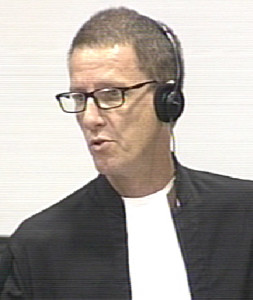
International Nuon Chea Defense Counsel Victor Koppe
Mr. Koppe then asked whether he knew at the time whether commander Roeun or the witness’s superior Ron were aware at the end of March that Vietnamese troops were planning to attack Democratic Kampuchea territory in April 1977. The witness confirmed this. “Yes, they knew, because we had also our plans” and the Vietnamese communicated through telegrams and radio. The Vietnamese prepared weapons and ammunition. The warehouse stored military equipment. “They learned of the plan”, but they could not counter the advancement of the Vietnamese troops. Asked how they knew that Vietnamese troops would attack in April, the witness told the court that the upper level knew and prepared for this event. He did not know the whole situation throughout the country. “However, I believe they all received the same plan”. He did not know the exact date. The attack had already taken place in March or April of that year. There were restrictions on the use of equipment and sometimes reshuffling of message encoders and decoders, the witness recounted. The changes occurred on a monthly basis.
When Mr. Koppe probed further on military conflicts in April 1977, Mr. Smith objected. Mr. Koppe replied that he was entitled to ask the question, since the witness had used these words. The objection was overruled, but Mr. Koppe instructed to simplify his questions. Mr. Koppe asked whether there were orders “to be extra vigilant” in the use of radiotelegraphs, for example. The witness answered that codes were frequently changed both for telegrams and radio communication. “Sometimes we had to change it within a fortnight”.
Turning back to the topic of Vietnamese forces taking parts of Cambodia, Mr. Koppe quoted the witness’s DC-Cam statement, in which he had said that Snuol was not yet taken in 1978.[11] The witness answered that on 10 November 1978, Vietnamese troops attacked them again after having retreated earlier. Vorn Vet went to Phnom Penh and was arrested later on. When he visited the area [in Kratie], he was received. “So please be mindful of the English translation, because otherwise you put me into trouble”. Vorn Vet made a two day visit to the area, but did not hear a broadcast during which it was said that he should be promoted to a military commander.
Mr. Koppe then asked about Dol. The witness answered that this person was higher in terms of authority. Although his leg was injured, “he could ride a motorbike”.
Mr. Koppe then wanted to know whether any of the six people that the Prosecution had talked about earlier had a connection to Vorn Vet. The witness answered that there were Vietnamese in the area. Some people who did not attend the meeting with Vorn Vet were not arrested. He assumed that they therefore had a connection with Vorn Vet. He himself had not attended the meeting.
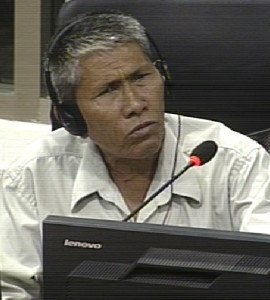
Witness 2-TCW-1005
He was told to take care of Phon’s wife before Phon left. He fled to the mountain range together with Dol. Mr. Koppe then asked about the arrest of Dol and wanted to know whether he was detained for a brief period of time by 502 forces close to Pochentong airport.[12] The witness recounted how he fled to the mountain with Dol. Asked about the arrest, he said that a few of the 11 people who were arrested were sent to Kampong Chhnang. Dol returned.
Later, they fled to Domreng Mountain. He could not recall all events that happened. Mr. Koppe probed him further on the arrest of the cadres, but he did not give much information. Asked about why he was happy that his leaders left, he said that he thought he could “enjoy life” while they were gone. Mr. Koppe asked whether the cadres often received instructions to go to Phnom Penh. The witness said that he did not receive letters to visit his hometown. When Mr. Koppe repeated the question, he said that his leaders once visited Phnom Penh for a meeting. They rarely came to Phnom Penh.
Mr. Koppe wanted to know whether there were restrictions on the use of radio communication after the 11 people had left. The witness answered that they considered themselves defeated. “So we had no radio communication”.
Killing of People
Turning to his next subject, Mr. Koppe asked whether he was aware of “anything that happened to Cham people in Kratie”. The witness answered that he did not know. “I have no knowledge of it.” He said there may have been clashes between the Khmer Rouge and rebellious forces. The witness affirmed this. For example, there was a road block when they were transporting ammunition. That time, there was one unit of rebellious soldiers.
Mr. Koppe asked whether he ever spoke to his ex-wife Prak Yut about her role during Democratic Kampuchea. He replied that he married his wife in 1982 and that she had joined the revolution long before him. She did not discuss in detail with him.
Mr. Koppe said that two newspaper reports had referred to Ta Mok as “the butcher” and asked whether the witness had heard about this. The witness said that “I would like to deny such an accusation”. He said that Ta Mok “was not a killer”. He then said that he would not want to deny this accusation, but that he was unaware of such a situation.
The President adjourned the hearing. It will continue tomorrow, July 28, 2016, at 9 am with the testimony of this current witness.
[1] E3/93.2
[2] E3/10628, at 01142606 (EN), 01127710 (KH).
[3] E3/10622, question 80.
[4] E3/10622, at answer 75.
[5] ibid., answer 64.
[6] E319/50.
[7] E3/765, at 00539994 (EN).
[8] E3/10622, answer 96.
[9] E3/9647, 01212283 (EN), 00975723 (KH), 00996564 (FR).
[10] ibid., 01212328 (EN), 00975746 (KH), 00996586 (FR).
[11] E3/9647, at 01212312 (EN), 00975742 (KH), 00996581 (FR).
[12] E3/10639, at answer 304-311.
